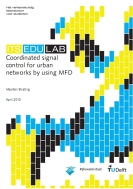Dynamic Traffic Management (DTM) is preferred rather than the construction of new roads to increase traffic performance. DTM measures are usually not coordinated and thus have no interaction with each other. It is possible that DTM measures solve a problem locally but create another problem elsewhere in the network. To manage the scale, a hierarchical approach can be considered in which an upper level control calculates the desired traffic states in the subnetworks it is responsible for. Recently, empirical evidence is found that the traffic state of an urban road network can be described by a diagram with a constant shape: the Macroscopic Fundamental Diagram (MFD). The MFD gives the relation between accumulation (number of vehicles in a network) and the weighted flow in the network.
The scope of the thesis is the control in a subnetwork by means of traffic light and ramp metering. As a control method, Model Predictive Control is used because of its ability to predict, combine multiple objective functions, to deal with multivariate processes and to consider constraints. The prediction model needed for MPC, is a macroscopic urban traffic model (S-model) and for the evaluation of the control methods the microscopic simulator VISSIM is used.
In a sensitivity analysis it appeared that the compatibility of the S-model and VISSIM is too low at this moment. The main source for this problem is the way link flow is modelled. The consequence of this is that the MPC controller cannot be used for conducting experiments. For the other control strategies it was found that fixed-time control performed better than semi vehicle actuated control. It was also found that the MFD is not yet suitable as a communication tool in a hierarchical traffic control concept, because it is not constant for the control method.
